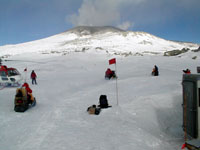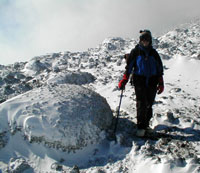|
|

|
|

|
Snowmobiles
carry geologists up the steaming summit cone of Erebus.
Click to enlarge.
|

|
|
|
|

|
|
Climbing
Erebus
|

|
From
the hut to the summit
by Paul Doherty
December
20, 2001
Noel
and I arrived at Lower Erebus Hut in a window of good weather.
We found Phil Kyle helping his team load snowmobiles so they
could rush up to visit their instruments on the mountain.
Phil
Kyle is a brave man, not only because he does science while
living for months at a time on the side of an erupting volcano
in Antarctica, but also because he gave Noel and I two of
his snowmobiles to drive up Mt. Erebus. Neither Noel or I
had ever driven a snowmobile before, we are into human powered
travel preferring to climb mountains on skis, snowshoes, or
on foot. Our first snowmobile ride was going to be up the
steep icy flank of a volcano!
Matt
Irinaga gave us survival lessons for driving a snowmobile.
Lesson
1. When you drive sideways across a steep icy slope put both
feet on the uphill side of the snowmobile and lean uphill.
This way if the snowmobile rolls over, your downhill leg won't
get crushed. This is not a theoretical lesson—the conditions
this year were so bad that even Phil, the most experienced
driver on Erebus rolled a snowmobile. Bill Fox didn't receive
this lesson so that when his snowmobile rolled over, his leg
was trapped underneath. Luckily the snow was soft and he wasn't
hurt.
Lesson
2. When you are driving down an icy slope don't lock up the
brakes, or you'll skid out of control.
Savor the speed. Which was easier said than
done.
|
|

|
|

|
Our
leader Jessie Crain stops to show us a volcanic bomb.
Click to enlarge.
|

|
|
|
|

|
I
got the hang of using the throttle on a two cycle engine and
of leaning to the sides on corners pretty quickly. I hate
to admit it, but it was fun navigating the snow between the
volcanic lava flows. We felt great after we successfully crossed
the steep icy slope and stayed right-side-up. Eventually,
the going got too tough for machines and we had to stop to
hike up the final 500 feet at the summit cone. Real climbing
a last!
Geology
grad student Jessie Crain led the way. She told us that if
the volcano erupted and threw out volcanic bombs, "don't
duck, look up watch them coming down then get out of the way."
That sounded like good advice.
It
was cold: -30 C (-22F) with 20+ mph (30 kph) winds. Exposed
flesh froze within minutes. Noel took off his face mask for
a few minutes to use the video camera, and before he was done,
a white patch of frostbite appeared on his nose.
When
we reached the rim of the crater the world dropped away 600
feet (200 m) into a steaming pit. The mist opened briefly
and let us see the coal black lava lake below us, it was laced
with incandescent red fractures. You can see the same view
on a live webcamera located on the rim of Mt. Erebus by visiting
the Mount Erebus Volcano Observatory, or
MEVO
,
web site.
|
|

|
|

|
A
view over the rim, down inside the crater of Erebus. Click
to enlarge.
|

|
|
|
|

|
Ten-foot
(3m) diameter icy tubes ran up the walls of the crater, steam
belched from their tops. They reminded me of the termite tubes
I saw in California, except these were a thousand times larger.
If these were made by mutant ice termites then I was in a
science fiction story. They were actually made by ice condensed
from the steam escaping from fumaroles.
Jessie
and Matt worked on her instrument mounted on the rim of Erebus.
In this instrument, an air pump sucks a known amount of air
through filters. The filters collect radioactive gases and
particles. Then the filters are sent off to Paris where their
radioactivity is measured. These measurements will allow Jessie
to determine the time that the lava erupting from Erebus spends
in the magma chamber beneath the volcano.
After
an hour of gathering data, and savoring the company of an
active volcano we headed back down the volcano. I remembered
not to brake as the speed built up riding the snowmobile down
the icy slope. It was a thrilling ride. I heaved a sigh of
relief when I reached the hut safely again.
|

